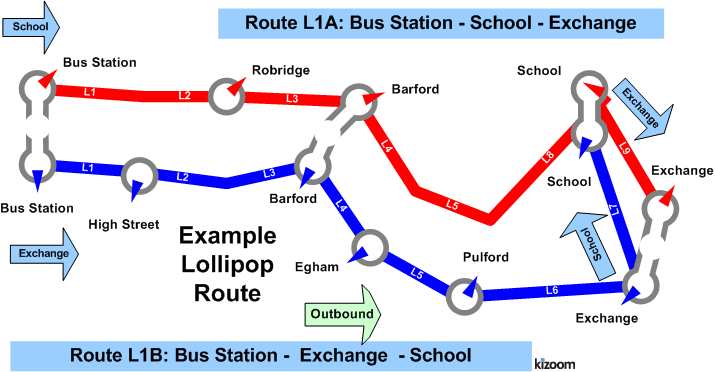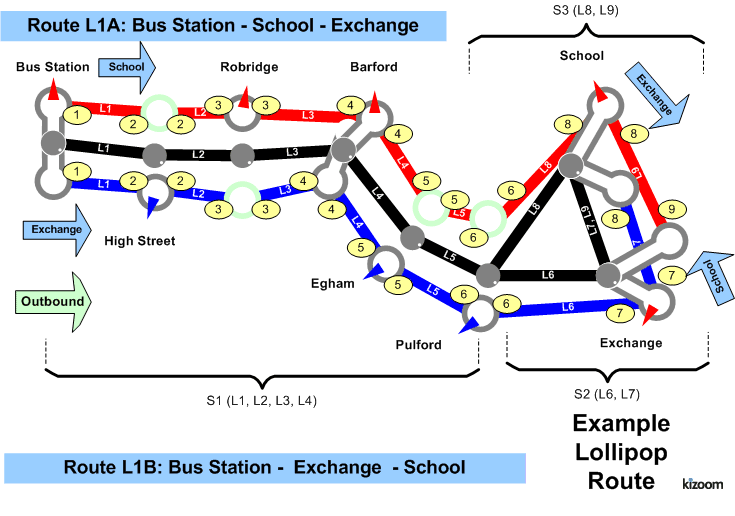TransXChange
Examples 2.1 - Lollipop route
Summary
Same stops covered by two different routes in different directions in a partial lollipop. See also Hail and Ride for a full lollipop topology.
- Lollipop route, with two journeys proceeding round the loop in opposite directions (In this example neither route completes the full lollipop course)
- Two services run by two different operators, sharing a line label.
- Two different physical routes with the same line label.
- Timing status on stop usage other than 'Principle Timing Point (PTP)
- Additional operating days for regular and bank holiday operation
- Express stopping pattern for some journeys.
- Use of Stop Sequence Numbers
- Use of Dynamic Destination headings
- Reuse of shared sections.
- Reuse of VehicleJourney Link
- Layover Point
- General Schema
Published as PDF:
- PDF general: Withpublish lollipop.xml -full TransXchange publisher option (includes all stops)
- PDF vosa: With publish lollipop.xml -vosa TransXchange publisher option (includes only stop usages with a timing status of 'PTP' )
Route Map

Timetable
Bus Station To Exchange
| Column | #1 | #2 | #3 | #4 | #5 |
| Operator | ACO | ACO | ACO | RED | ACO |
| Line | 1B | 1A | 1B | 1B | 1B |
| Bus Station | 15:55 | 16:15 | 16:35 | 16:40 | 16:55 |
| High St | <16:46 | ||||
| Robridge | 16:26 | ||||
| Barford | 16:09 | 16:29 | 16:49 | 16:54 | 17:09 |
| Egham | 16:12 | 16:52 | 16:57 | 17:12 | |
| Pulford | 16:15 | 16:55 | 17:00 | 17:15 | |
| Exchange | 16:32 | 16:52 | 17:12 | 17:32 | |
| School | 16:53 | 17:16 | |||
| Exchange | 17:17 |
The XML Representation
Service Registration
- The service is not registered
- There are two Operator instances, 'ACO'. and 'RED'
Service Structure
The detailed map below shows the sections and stop sequences used.
- There are two Serviceinstances whose Lines are labelled to appear to the public as the same:
- S1, which has two Line instances; L1, labelled 'L1A', andL2, labelled 'L1B' S1 is run by Operator 'ACO'
- S2 which has Line L3 also labelled 'L1B'. S2 is run by Operator 'RED'
- There are three RouteSectioninstances;
- RS1: 'Bus Station' to 'Pulford', containing RouteLink instances RL1 to RL5
- RS2: 'Pulford' to 'School ' via 'Exchange', containing RouteLink instances RL6 and RL7
- RS3: 'Pulford' to 'Exchange' via 'School', containing RouteLink instances RL8 and RL9.
- There are two Routeinstances:
- R1: 'Bus Station to School (via Exchange)', containing RS1 and RS2.
- R2: 'Bus Station to Exchange (via School)', containing RS1 and RS3.
- There are three corresponding JourneyPatternSection instances, JS1, JS2 and JS3, one for each route section.
- Egham is not a 'Principle Timing Point' ('PTP'), so for the call at Egham the JourneyPatternTiminkLink has an override TimingStatus of 'Timing Information Point' (''TIP')
- S1 has two JourneyPatterninstances:
- JP1: Following Route R1, with sectionsJS1 andJS2, passing 'Pulford' without stopping
- JP2: Following Route R2, with sectionsJS1 andJS3.
- S2 has one JourneyPatterninstance:
- JP3: Also following Route R2, with sectionsJS1 andJS3, passing 'Pulford' without stopping. It contains two named layover points lay_1 and lay_2.
- There are five VehicleJourney instances, one for each colum
- S1 has three VehicleJourney instances:
- VJ1: following JourneyPattern JP1 over Route R1, 'Bus Station to School (via Exchange)' , as Line 'L1B', passing 'High Street' and 'Robridge', without stopping. Short working of the second section, i.e. termination at Exchange, is indicated by a dead run.
- VJ2: also following JourneyPattern JP1 over Route R1, 'Bus Station to School (via Exchange)' but as Line 'L1A', passing 'High Street', 'Egham' and 'Pulford' without stopping
- VJ3: reuses the timing links of VJ1, and so also follows JourneyPattern JP1 over Route R1, 'Bus Station to School (via Exchange)'
- VJ5: reuses the timingg links of VJ1, and so also follows JourneyPattern JP1 over Route R1, 'Bus Station to School (via Exchange)'
- S2 has one VehicleJourney instance:
- VJ4: following JourneyPattern JP3 over Route R2, 'Bus Station to Exchange (via School)', as Line L3 , which has the same label of 'L1B' as S1/L2 , although it actually goes round the last two stops in a different sequence from the other journeys with the same label, and so needs a different underlying Route. VJ4 passes 'Robridge', without stopping
Operating Days
- The Service operating period for SV_1 starts on01/01/2004 for all vehicle journeys, and continues until 13/06/2005
- The OperatingProfile for the Service SV_1 states values that apply to all journeys unless overridden on a journey pattern or individual vehicle journey.
- The RegularDayType DaysOfWeek specifies journeys of the service by default runs Monday to Saturday throughout the year
- The BankHolidayOperation / DaysOfOperation states journeys of the service run on Jan2ndScotland, MayDay, EasterMonday, SpringBank, AugustBankHolidayScotland, ChristmasDayHoliday, BoxingDayHoliday and ChristmasEve.
- The BankHolidayOperation / DaysOfNonOperation states journeys of the service do not run on ChristmasDay, BoxingDay, GoodFriday, NewYearsDay, NewYearsDayHoliday and NewYearsEve.
- The Vehicle Journeys VJ1 and VJ5 have a different set of day type specified
- The RegularDayType DaysOfWeek specifies journeys of the service run Monday, Wednesday, Friday, Sunday throughout the year
- The Service operating period for SV_2 starts on 01/01/2004 for all vehicle journeys, and continues until 13/06/2005
- The OperatingProfile for the Service SV_2 states values that apply to all journeys unless overridden on a journey pattern or individual vehicle journey.
- The RegularDayType DaysOfWeek specifies journeys of the service by default runs Monday to Sunday throughout the year
- The BankHolidayOperation / DaysOfNonOperation states journeys of the service do not run on Christmas, ie ChristmasDay, and Boxing day
Use of Sections & Stop Sequence Numbers
Sections are used to reuse links between journeys.
Stop sequence numbers are used to coerce a specific ordering of the stops within a matrix timetable when published. The following diagram shows the journey pattern sections annotated with stop section numbers.
Page last updated: 2013/04/13



